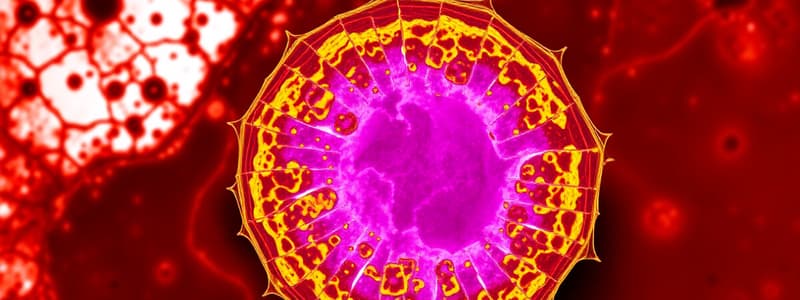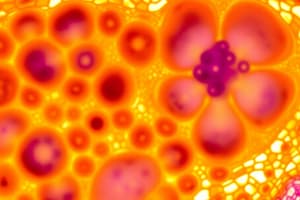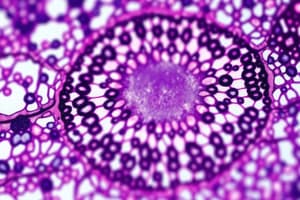Podcast
Questions and Answers
Which of the following cellular components is directly responsible for regulating the transport of substances into and out of the cell?
Which of the following cellular components is directly responsible for regulating the transport of substances into and out of the cell?
- Nucleus
- Golgi apparatus
- Plasma membrane (correct)
- Cytosol
A cell requires a large amount of ATP to function. Which organelle would likely be abundant in this type of cell?
A cell requires a large amount of ATP to function. Which organelle would likely be abundant in this type of cell?
- Mitochondria (correct)
- Golgi apparatus
- Lysosomes
- Smooth endoplasmic reticulum
If a cell is actively synthesizing steroid hormones, which of the following organelles would be the MOST prominent?
If a cell is actively synthesizing steroid hormones, which of the following organelles would be the MOST prominent?
- Lysosomes
- Rough endoplasmic reticulum
- Smooth endoplasmic reticulum (correct)
- Ribosomes
A researcher is studying a cell that is actively breaking down damaged organelles. Which of the following organelles is MOST likely involved in this process?
A researcher is studying a cell that is actively breaking down damaged organelles. Which of the following organelles is MOST likely involved in this process?
Which of the following best describes the primary function of ribosomes?
Which of the following best describes the primary function of ribosomes?
Which of the following series of events BEST describes the journey of a protein destined for secretion from the cell?
Which of the following series of events BEST describes the journey of a protein destined for secretion from the cell?
A cell is found to have a high concentration of enzymes that catalyze detoxification reactions. Which organelle is likely to be highly developed in this cell?
A cell is found to have a high concentration of enzymes that catalyze detoxification reactions. Which organelle is likely to be highly developed in this cell?
What is the primary purpose of the inner membrane of the mitochondria being folded into cristae?
What is the primary purpose of the inner membrane of the mitochondria being folded into cristae?
Which cellular component is directly involved in the synthesis of proteins?
Which cellular component is directly involved in the synthesis of proteins?
If a cell needs to increase ATP production, which organelle would likely be more abundant?
If a cell needs to increase ATP production, which organelle would likely be more abundant?
Which type of epithelium is best suited for diffusion and filtration?
Which type of epithelium is best suited for diffusion and filtration?
What cellular structure is responsible for modifying and packaging proteins and lipids?
What cellular structure is responsible for modifying and packaging proteins and lipids?
What characteristic is used to classify epithelial cells?
What characteristic is used to classify epithelial cells?
Which of the following cell types produce cartilage?
Which of the following cell types produce cartilage?
Which type of muscle tissue is responsible for voluntary movements?
Which type of muscle tissue is responsible for voluntary movements?
What is the function of intercalated discs in cardiac muscle?
What is the function of intercalated discs in cardiac muscle?
Which cellular structure transmits signals to other neurons?
Which cellular structure transmits signals to other neurons?
Which of the following is the function of glial cells?
Which of the following is the function of glial cells?
What type of stain is most commonly used in histology?
What type of stain is most commonly used in histology?
For what purpose is Periodic Acid-Schiff (PAS) stain used?
For what purpose is Periodic Acid-Schiff (PAS) stain used?
What type of microscopy provides the highest magnification and resolution?
What type of microscopy provides the highest magnification and resolution?
What is a common artifact that can be introduced during tissue processing?
What is a common artifact that can be introduced during tissue processing?
Which of the following is NOT a function of the endoplasmic reticulum?
Which of the following is NOT a function of the endoplasmic reticulum?
Flashcards
Histology
Histology
The study of the microscopic structure of tissues.
Plasma Membrane
Plasma Membrane
Outer boundary of the cell, composed of a phospholipid bilayer with embedded proteins, regulating substance movement.
Cytoplasm
Cytoplasm
All cell contents between the plasma membrane and the nucleus, including cytosol and organelles.
Cytosol
Cytosol
Signup and view all the flashcards
Organelles
Organelles
Signup and view all the flashcards
Endoplasmic Reticulum (ER)
Endoplasmic Reticulum (ER)
Signup and view all the flashcards
Golgi Apparatus
Golgi Apparatus
Signup and view all the flashcards
Mitochondria
Mitochondria
Signup and view all the flashcards
Ribosomes
Ribosomes
Signup and view all the flashcards
Nucleus
Nucleus
Signup and view all the flashcards
Nuclear Envelope
Nuclear Envelope
Signup and view all the flashcards
Nucleolus
Nucleolus
Signup and view all the flashcards
Lysosomes
Lysosomes
Signup and view all the flashcards
Epithelial Cells
Epithelial Cells
Signup and view all the flashcards
Squamous Epithelium
Squamous Epithelium
Signup and view all the flashcards
Cuboidal Epithelium
Cuboidal Epithelium
Signup and view all the flashcards
Columnar Epithelium
Columnar Epithelium
Signup and view all the flashcards
Fibroblasts
Fibroblasts
Signup and view all the flashcards
Study Notes
- Histology involves the study of tissues' microscopic structure.
- Cell histology is centered on cells' microscopic structures.
- Cell histology is critical to diagnosing diseases.
Cell Components
- Cells are made up of the plasma membrane, cytoplasm, and nucleus.
Plasma Membrane
- The plasma membrane is the outer boundary.
- It has a phospholipid bilayer with proteins.
- The plasma membrane controls substance movement.
- Membrane proteins serve as receptors, channels, or carriers.
Cytoplasm
- Cytoplasm has the cell contents between the plasma membrane and nucleus.
- It contains cytosol and organelles.
Cytosol
- Cytosol is the fluid part of the cytoplasm.
- It contains water, ions, enzymes, and other molecules.
Organelles
- Organelles are structures with specific functions.
- Key organelles include the endoplasmic reticulum, Golgi apparatus, mitochondria, lysosomes, and ribosomes.
Endoplasmic Reticulum (ER)
- The endoplasmic reticulum is a network of interconnected membranes.
- There are two ER types: rough and smooth.
Rough ER
- Rough ER has ribosomes attached.
- It helps with protein synthesis and modification.
Smooth ER
- Smooth ER lacks ribosomes.
- It helps with lipid synthesis, detoxification, and calcium storage.
Golgi Apparatus
- The Golgi apparatus contains membrane-bound sacs called cisternae.
- It processes and packages proteins and lipids.
- Modifies and sorts proteins from the endoplasmic reticulum and packages them into vesicles.
- Vesicles transport proteins elsewhere.
Mitochondria
- Mitochondria are the cell's powerhouses.
- They generate ATP through cell respiration and have a double membrane.
- Inner membrane folds (cristae) increase ATP production surface area.
- Mitochondria contain their own DNA and ribosomes for protein production.
- They participate in apoptosis.
Lysosomes
- Lysosomes have digestive enzymes in a membrane.
- They break down waste and debris and participate in autophagy, which removes damaged organelles.
- Lysosomes aid phagocytosis where cells engulf particles.
Ribosomes
- Ribosomes perform protein synthesis, in the cytoplasm or on the rough ER.
- They consist of ribosomal RNA (rRNA) and proteins.
- Ribosomes translate messenger RNA (mRNA) into proteins.
Nucleus
- The nucleus is the cell's control center, containing the cell's DNA.
Nuclear Envelope
- The nuclear envelope is a double membrane, containing nuclear pores.
- Nuclear pores regulate substance movement.
Chromatin
- Chromatin contains DNA and proteins that form chromosomes.
- Chromatin condenses during cell division.
Nucleolus
- The nucleolus is where ribosome synthesis occurs, and it is located inside the nucleus.
Cell Structures and Their Functions
- Plasma Membrane - A barrier that regulates substance movement
- Cytosol - Fluid with water, ions, and enzymes
- Ribosomes - Protein synthesis
- Endoplasmic Reticulum - Modifies lipids
- Golgi Apparatus - Packages proteins and lipids
- Mitochondria - ATP production
- Lysosomes - Breaks down waste
- Nucleus - Control center with genetic material
Cell Identification
- Cell identification relies on morphology and staining.
- Different cell types have varying shapes, sizes, and staining.
Epithelial Cells
- Epithelial cells line surfaces, cavities, and glands.
- They are classified by shape (squamous, cuboidal, columnar) and arrangement (simple, stratified).
Squamous Epithelium
- Squamous epithelium contains flattened cells.
- Simple squamous epithelium facilitates diffusion, such as the lungs and kidneys.
- Stratified squamous epithelium protects against abrasion, such as the skin.
Cuboidal Epithelium
- Cuboidal epithelium contains cube-shaped cells.
- Simple cuboidal epithelium is in glands/kidney tubules.
Columnar Epithelium
- Columnar epithelium contains tall, column-shaped cells and lines the gastrointestinal tract.
- Columnar Epithelium may have cilia or microvilli.
Connective Tissue Cells
- Connective tissue cells support, connect, and protect and include fibroblasts, chondrocytes, osteocytes, and adipocytes.
Fibroblasts
- Fibroblasts produce the extracellular matrix and are found in connective tissue.
Chondrocytes
- Chondrocytes create cartilage, and are found in cartilage tissue.
Osteocytes
- Osteocytes maintain bone tissue and are found in bone tissue.
Adipocytes
- Adipocytes store fat and are found in adipose tissue.
Muscle Cells
- Muscle cells aid movement, with skeletal, smooth, and cardiac types.
Skeletal Muscle
- Skeletal muscle connects to bones for voluntary movement.
- It contains cylindrical cells with multiple nuclei, and appears striated due to protein arrangement.
Smooth Muscle
- Smooth muscle is in organ and blood vessel walls for involuntary movement.
- Smooth muscle cells are spindle-shaped, and have a single nucleus.
Cardiac Muscle
- Cardiac muscle is exclusively in the heart for pumping blood.
- Cardiac muscle cells branch and have a single nucleus, and are linked by intercalated discs for coordination.
Nerve Cells
- Neurons transmit electrical signals.
- Neurons contain a cell body, dendrites, and an axon.
Cell Body
- The cell body houses the nucleus and organelles.
Dendrites
- Dendrites receive signals from other neurons.
Axon
- The axon sends signals to other neurons or target cells.
Glial Cells
- Glial cells support and protect neurons can include astrocytes, oligodendrocytes, and microglia.
Staining Techniques
- Staining enhances the visibility of cellular structures.
- Stains can include hematoxylin and eosin (H&E), periodic acid-Schiff (PAS), and trichrome stains.
Hematoxylin and Eosin (H&E)
- Hematoxylin stains DNA/RNA blue or purple.
- Eosin stains proteins pink or red and is the most common stain.
Periodic Acid-Schiff (PAS)
- PAS stains carbs and glycogen magenta.
- It helps find basement membranes/glycogen.
Trichrome Stains
- Trichrome stains use multiple dyes to color tissue components and can highlight collagen fibers.
Microscopy Techniques
- Microscopy visualizes cells/tissues.
- Common types are light, electron, and fluorescence microscopy.
Light Microscopy
- Light microscopy uses light and is used to view cells, tissues, and cellular structures.
Electron Microscopy
- Electron microscopy uses an electron beam for higher magnification.
- TEM views internal structures, while SEM views surfaces.
Fluorescence Microscopy
- Fluorescence microscopy uses fluorescent dyes to label structures and visualize molecules.
Artifacts
- Artifacts are abnormal structures and are introduced during processing/staining.
- Common artifacts include folds, shrinkage, and precipitates.
Studying That Suits You
Use AI to generate personalized quizzes and flashcards to suit your learning preferences.




